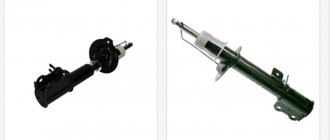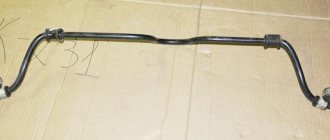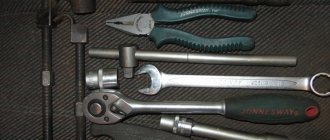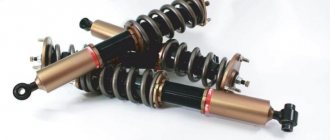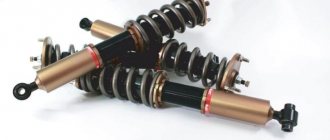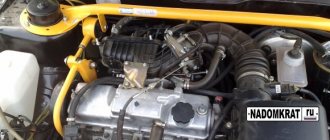15 August 2022 36,434
Among owners of Lada Granta and Lada Kalina cars, one of the suspension modifications is very popular. It is notable for the fact that there is no need to redo anything, and for little money we get a tangible effect. Let's figure out what you need to buy and install yourself for this.
The point of the modification is to replace the standard disc suspension limiter with a rubberized one from Peugeot
. You can read the reviews at the end of the article.
Reviews
Review #1 (author)
The suspension became very quiet, the banging noise disappeared, I’m very pleased with the result! The factory washers are metal, and when the struts are released, they hit the rubber and you get unpleasant knocks, but the Peugeot washer is rubberized, and in this case, rubber on rubber knocks much quieter.
Review No. 2 (author)
The effect is amazing, soft and very elastic suspension, the suspension has become much quieter and more pleasant. Now only the rack needs to be repaired, it rattles like a nightmare, and the washers transmit this noise well to the body.
Review No. 3 (author)
Review No. 4 (author)
Alas, in urban driving conditions in slushy snow, no changes in the suspension performance were noticed. On the recumbent stands, they hit the rebound just as vigorously as they hit, especially the right one. The only thing is that on small irregularities, it seems that less vibrations are transmitted to the body, but again, everything is at the level of nuances.
Causes and signs of failure, diagnostics
The node takes a dynamic (variable) load, and failure, as well as replacement, is usually required for several reasons:
- Part wear, time to failure (service life);
- Accidents, frequent driving in potholes, aggressive driving style;
- Contamination of the support bearing from the inside, ingress of moisture and dust;
- Malfunction of suspension (shock absorbers, springs).
The main sign that a support bearing will need to be replaced is that the Granta is rattling and creaking under the hood or near the struts. This appears after 80-100 thousand kilometers, under appropriate operating conditions of the car.
The design of the “support” and the front pillar is complex; the following elements can fail:
- The entire support, including the body (rarely) – position 4;
- Support bearing (more often) – position 8;
- Rubber gaskets wear out (more often) - position 9.
Diagnostics of support bearings
To diagnose a breakdown, do the following:
- Raise the hood, find the front supports;
- Place your hand over the knot;
- Start to strongly rock the car from bottom to top (or ask an assistant);
- If you feel a knock or hear, as well as other incomprehensible sounds, it means that there are problems. It is worth disassembling or replacing the front support mechanism.
- Watch the diagnostic video:
Causes of bearing failure
The main cause of support bearing failure is dust and water, which inevitably penetrate inside. The lack of lubrication does not have the best effect. Sharp blows to the rack will not add to the service life. It is worth taking into account the quality of roads, because they have a direct impact on the natural wear of the support bearing. That is why, with us, a part can wear out faster than its manufacturer claims.
Dirt and sand are some of the hardest impacts on a bearing. We remember that a journal bearing is a type of rolling bearing, and it does not have any protection mechanisms against harmful factors. Driving at high speeds and harsh brakes, especially on bad roads, also do not add to the service life of the part in question. However, not only the bearing itself suffers from this, but also all other suspension elements as a whole will soon require repair.
Procedure for replacing the front strut support bearing - Lada Granta
Removing the front pillar
- Before raising the car on a jack, loosen the hub nut with a 30 mm wrench.
- Don’t forget to first straighten the jammed collar at the locknut.
- Next, we also loosen the wheel bolts, only then raise the front of the car.
- We remove the wheels and proceed to dismantling the brake caliper.
- We unscrew the caliper fastenings, before unbending the protective brackets. Immediately remove the brake hoses from the strut.
- If you have an ABS sensor, do not forget to disconnect it by unscrewing the fasteners. We release the caliper from the fastenings, remove it and put it aside. Be sure to remember the position of the pads.
- Then we loosen the fastening of the steering tip with a 19 key, first disconnecting the cotter pin.
- We install a special removable device for tips.
- We press it out, tightening the thread, as shown in the photo.
- Thus, the tip can be easily removed without using a hammer.
- Under the brake disc we find two ball screws.
- First we loosen them and then unscrew them with a ratchet.
- As a result, the rack is disconnected from below. We take out the structure from the CV joint and place a support under it.
- The upper part of the rack holds three 13 nuts, unscrew them.
- Carefully pull out the stand from below. This completes the dismantling.
Hello. Chassis repair is perhaps the most common work that a car owner has to do, or more accurately, “our” car owner has to do. These constant knocks and squeaks seem impossible to completely “defeat”, and after one is put in order, another goes out of order. In general, this is not strange, given the state of the roads in Russia. Constant loads and driving on uneven roads have the most unfavorable effect on the chassis. In principle, it would probably be wrong to blame the roads alone; part of the problem certainly lies with the designers of AvtoVAZ, who, despite problems with the roads, continue to produce cars with flimsy suspension and chassis. Well, enough of the ranting, I think, we need to get to work.
Causes of bearing failures
As is the case with increased wear of other car parts, the support bearing often fails due to domestic off-road conditions. First of all, there are a large number of holes and potholes. The support is subjected to greater loads than it can withstand. That is why, when driving frequently on bad roads, the part needs systematic diagnostics.
Another reason is dirt getting inside the bearing. Its design does not provide any protection, therefore it is open to contaminants entering under the car body from the outside. Again, the quality of the road surface also contributes to this.
Low quality characteristics of new components are a common situation in our automotive parts market. Therefore, one should not be surprised that the support rod lasted half as long as the manufacturer promises.
How to check support bearings on Kalina
Before replacing the support bearings on the Lada Kalina, you should make a diagnosis and make sure that the “support” has failed , so check out the signs of failure:
- Clicks, knocks of Kalina’s “supports” (audible under the hood, when the shock absorbers are operating);
- A cracking sound is heard from the front side under the hood (when turning);
- Handling deteriorates, play at the steering wheel increases;
- You can feel the bumps in the road through the steering wheel.
If such signs are present, then there is a 99% chance that replacing the support bearing of the Kalina front strut is inevitable, but first make a diagnosis.
- Place the car on a flat surface and open the hood.
- Find the upper support, press this place with your palm.
- Rock the car from bottom to top so that Kalina's front strut supports and shock absorbers work.
- If you feel or hear knocking noises, it means it's time to replace the support bearing.
- Ask an assistant to rotate the steering wheel and listen to how the unit works; when in good condition, the “support” functions silently.
Attention:
Watch a video of clicks and knocks from the “opornik”, as well as how to perform diagnostics.
Recommendations for repair and assembly
Advice:
The videos will help you make a replacement and speed up the process of repairing your Grant.
Replacing the front shock absorber strut support:
Replacing the support bearing on Grant:
- If the shock absorbers are oil, then the rod goes down to the bottom. Therefore, we assemble the mechanism quickly. It is easier with gas and combined models, since the rod only rises upward. In the case of an oil product, do not forget to pump them and remove air.
- If you are installing the original front mount, replace the factory metal washers on both sides of the damper. When installing “supports”, for example SS20, this is not required; they are included in the kit.
Malfunctions
The main sign of a failed support bearing is a knocking sound (dull knocks) in the area of the shock absorber strut. It may indicate that:
- the rubber gasket is damaged or deformed;
- The bearing itself is damaged.
Failure of the support bearing may occur due to:
- resource spent;
- penetration of dirt and moisture;
- exceeding permissible loads;
- mechanical damage due to shock absorber malfunctions.
How to identify a malfunction
To diagnose a support bearing failure, open the hood and remove the “cup” cover. Place your palm on the shock absorber housing and rock the front of the car. If you hear a knock and feel the corresponding vibration with your hand, the bearing is clearly faulty.
When to change
The service life of the “supports” is on average 50-100 thousand km, depending on the conditions in which the car is operated. After this resource has expired, it is recommended to change them. Replacement is also necessary if any malfunctions are detected.
Late diagnosis, as well as ignoring bearing failure, threatens to destroy the shock absorber structure and other suspension elements.
Methods for checking the rear support assembly
We recommend reading 2 ways to diagnose the rear strut support assembly. It's good if someone helps you.
The first method (on the go), as for checking the front support bearings
- find your way on a road with bumps and obstacles;
- ride on uneven surfaces, changing the speed;
- accelerate, brake, turn on obstacles - load the rear supports.
Bumps and crunching sounds from the rear indicate that it is time to change the rear support.
A bad sign is malfunctions in the rear shock absorbers, “breakdowns” during these impacts.
The second method (on the site), as for checking the front supports
- it is necessary to install the car horizontally;
- put the vehicle on the handbrake;
- secure the wheels with wooden wedges;
- find the rear strut supports in the luggage compartment;
- remove the lining and protection, if necessary. Get to the rear shock absorber rod mounting nut;
- press the nut (upper element of the strut support) with your fingers;
- ask your friend to rock the back of the car. A knocking and crunching sound, the same as you heard when moving, or if the rod moves relative to the support (you can feel this with your hand), the condition of the system is unsatisfactory. The situation can only be corrected by installing a new one.
How to change a support bearing without a wheel alignment on a Lada Kalina
Replacing the support bearing on Kalina without removing the strut is impossible, or will not be correct, but replacing the part without further camber is still possible. In this case, the technology for removing the rack will change:
- After removing the wheel, unscrew the hub lock nut.
- Disconnect the steering knuckle from the ball joint and steering rods.
- Then we remove the steering knuckle from the CV joint with the strut and shock absorber spring, this way you will not break the camber bolts.
Why are bearings needed at all, where are they located and what types are they?
Support bearings are the connecting elements of the front hydraulic shock absorber strut and the vehicle body. They are different:
- with a built-in ring (external or internal) - such bearings can be recognized by the presence of special holes in them for mounting (pressure flanges are not required for their installation);
- with a detachable ring (also internal or external);
- singly divided - considered the most durable.
Support bearings are needed (regardless of their type) in order to dampen axial and radial vibrations of the shock-absorbing strut support and prevent it from jumping out of the space provided for it, while simultaneously ensuring the mobility of the connection between the support and the body. In this case, the load on the node is simply colossal. Designers understand this, so this part is made from high-strength alloys, but they do not make it “immortal”.
Domestic off-road conditions only shorten the service life of bearings, so at least every 20,000 km. mileage, it is recommended to check their condition, as, however, this should also be done in cases where there are doubts about its serviceability: a knocking/crunching sound is heard from under the hood or other signs are noticed.
Replacement
- jack;
- wheel wrench;
- open-end wrench 19;
- open-end wrench 17;
- socket wrench 13;
- pliers;
- ring wrench 22 and open-end wrench 9;
- special puller for tie rod ends;
- 2 special spring ties.
Execution order
- We park the car on a level surface and put it in gear.
- We jack up its front part on the desired side and remove the wheel.
- Using pliers, unscrew the nut securing the steering tip to the strut and unscrew it with a 19 mm wrench.
- Using a tip remover, remove the tip pin from the shock absorber strut. As a last resort, the finger can be knocked out by prying it up with a small pry bar and carefully tapping it from below.
- Using a 19mm wrench, unscrew the 2 nuts securing the strut to the steering knuckle. If necessary, hold the bolt heads with a 17 wrench.
- Using a 13 mm socket wrench, unscrew the 3 nuts securing the support to the body.
- We remove the entire shock absorber.
- We install two ties on the shock absorber spring and compress it until the upper part of the shock absorber is released.
- Using wrenches 22 and 9, unscrew the upper support nut on the upper side of the shock absorber.
- We remove the support, disassemble it, and remove the worn support bearing.
- We install a new one in its place.
- We install the shock absorber in the reverse order.
Step-by-step technology for replacing the support bearing without removing the strut
- After hanging the wheel with a jack, remove it and put it aside.
- We dismantle the stabilizer strut in order to prevent restriction of the free movement of the rack assembly.
- Armed with a hexagon, insert it into the recess at the end of the rod and hold it while unscrewing the central nut, which directly fixes the rod itself.
- We roll the jack under the center of the ball pin and raise the stand until the load is removed from the auxiliary jack. The stand begins to show play.
- Using zip ties, we compress the spring coils. We simulate the compression amount to be insignificant, after which we unload the jack, which was used to lift the rack itself. The stand, following the jack lever, goes down.
- Now is the time to “separate” the support bearing from the rod. We carry out the manipulation - we move the rod down and remove the “support” from it through the void that appears under the body cup.
- We clean the support cup and its rubber seal from dirt accumulations. When installing the “SS-20” supports, there is no need for a lower cup.
- Next, we assemble, taking care to follow the reverse sequence to dismantling. We recommend lubricating the fasteners with graphite substance.
- Having completed the installation procedure, we check the tightening torques on all fastening units.
- We install the wheel in its original place and proceed to a similar procedure on the second side of the car.
Upper front strut support for Kalina - features of choice
As practice shows in most cases, the upper support assembly is replaced. There are three models of “supports” on sale, which you should pay attention to when purchasing.
The photo below shows original sets of supports from three companies: SEVI. SS20 (SS20), ASOMI (ASOMI). The cost of products varies from 2000 rubles. up to 4000 rub. depending on the configuration.
Watch the video on spare parts review: Comparison of Lada Granta support bearings with EUR
Replacement strut support for Lada Kalina
What are the best rack supports for Granta?
The main requirements for Granta and Kalina 2 support bearings are endurance and reliability. The support bearing takes the entire load from the car body, as well as from the shock absorber strut, allowing the latter to rotate freely around the longitudinal axis.
The dynamic loads of the shock absorber rod are absorbed by a rubber damper. The more reliable it is, the longer the support will last. The spring rests against a support cup with a rubber-coated ball support bearing. However, different manufacturers offer different solutions for support.
Prop with modified caster
Thus, some supports are produced with reinforced bearings (balls of larger diameter), there are supports with a changed caster angle. To do this, the axis of the shock absorber strut is shifted by 6 or 12 mm, which ensures a change in the caster angle to 1°40′ or 2°45′, respectively.
In addition, supports are produced both for Lada Granta and Kalina 2 with electric power steering (article 21900-2902821-10), and for cars without electric power steering (article 21900-2902821-00).
Standard supports cost about $12 apiece, owner reviews about them are not the most encouraging, so most often you have to buy replacements for the original:
- Support bearing SS20 series Master, Gold, Drive, differ in caster angle and damper design. They last quite a long time and are easy to install. The price is about 26 dollars per piece.
ANVIS 2190
Rack Mounts , $27/pair, 6mm offset. Available for both Granta and Kalina 2 with and without EUR. Compatible with all types of springs (11190 or 11196), as well as the most popular KAYABA or SACHS struts. Sevi thrust bearings starting at $20 per pair. A budget option with the strut tilted by 1 degree and the shock absorber axis shifted back by 6 mm. Demfi , article number dff21901 (2190-2902822-12), are sold without a support bearing, which has catalog number 1118-2902840 . The price is about 15 dollars. Reviews are contradictory.
Technologies of the future , article number 2192-2902821 , price about 26 dollars per pair. There are few reviews, mostly positive. Budget Slovak supports LSA , sold without bearings, price about $10 per pair. supports (SA 0156) , complete with bearing, price 10 dollars apiece, run well, good assembly, bearing of standard sizes.
How to replace support brackets on Kalina yourself
To replace the bearing, in addition to a standard set of keys, you will need special pullers to remove the support and spring tensioner.
Unscrew the support and remove the stand
So, in order to unscrew the support we need a special key. With its help, we can easily unscrew the fastening nut as shown in the photo below.
We put a special wrench on the support nut; for ease of unscrewing, we will need a larger lever (a regular one with a diameter will do). We begin to unscrew the support as shown in the photo.
If you don’t have a special tool at hand, then take a regular 22mm socket wrench and put it on the nut, use a 9mm wrench to hold the rod from turning and unscrew the fastening nut. After we have unscrewed the nut, we proceed to remove the shock absorber strut.
Disconnect the brake hoses that are attached to the strut. Next, unscrew the two bolts securing the strut to the steering knuckle. To easily unscrew them, we recommend spraying them with penetrating lubricant or WD40 and letting them sit for a couple of minutes. After this, you can easily unscrew the bolts without fear of stripping the threads.
Next, unscrew the nut securing the steering end to the strut. This can be done either using a special puller as shown in the photo, or knocking the tip out of the rack with a hammer. Now all that remains is to unscrew the 3 upper bolts securing the strut with the support to the body and pull it out.
Removing the old and installing a new support bearing
After we have removed the strut, we take two spring ties, put them on the spring and begin to tighten them until we can unscrew the nut. After unscrewing the top fastening nut, you can easily remove the support along with the bearing, cup and rubber band. If the anther is intact, you can leave it alone.
We take a new support bearing, put it on the stand and assemble it in the reverse order. Instead of factory rubber bands, you can install sound insulators from SS20, which are said to prevent squeaking. After we have assembled the rack with the new support, we remove the spring ties and install it in place.
Article rating:
Which support bearing is better to put on a viburnum Link to the main publication
Overview of the main shock absorber manufacturers
By default, hydraulic ones from SAAZ (Skopovsky Automobile Plant) are installed from the factory. They are not particularly distinguished by their quality, but with moderate use they can last up to 60,000 km.
- Kayaba : Japanese, characterized by high quality, reliability, and long service life. When purchasing, be careful, as some of the products are made in China.
- ASOMI: domestic manufacturer for GAZ, VAZ, LADA models. One year warranty from the date of installation. Judge the quality for yourself.
- SS (SS): also a domestic manufacturer of racks for VAZs. Quality guarantee for two years, according to the owners' reviews, they are not bad, a little harsh.
In general, all shock absorbers are divided into three categories:
- Highway;
- Standard;
- Sport.
How to diagnose a faulty bearing: instructions.
- Turn off the car and protect it from rolling away with the handbrake or using stops.
- Open the hood.
- Remove the cover from the “cup” located on the hub bearing.
- Having pressed the bearing with your palm so that the stand does not move, ask someone to rock the car in different directions.
- Listen. If the support creaks/knocks, it needs to be replaced.
But be careful, the knocking/crunching sound should come from the bearing, and not just from the suspension, since in this case the problem may not lie in it, but in the steering rack, steering cardan or steering shaft.
Sequence of actions when replacing the front shock absorbers of a Lada Granta with your own hands
We prepare a set of tools, rags, WD-40 fluid, a set of new racks, and other components for related repairs.
- We place the car within the perimeter of the repair area, jack it up, and secure the rear row of wheels with wheel chocks;
- We remove the wheel, disconnect the tie rod end, the ball joint;
- We loosen the rod (key to “9”), while holding the main nut to “22”;
- With a key set to “13”, unscrew the three nuts securing the upper support;
- In order to minimize the violation of the camber angle - wheel toe, we use a chisel to mark the relative placement of the steering knuckle and the bracket;
- Unscrew the bolts at the bottom of the fastening (key set to “17”);
- We remove the Grant shock absorber assembly;
- Use a puller to compress the spring several turns.
Removing the shock absorber strut and disassembling it
We remove and disassemble the shock absorber strut when it is necessary to replace the upper support, bearing, spring, and telescopic strut. The telescopic stand is non-removable and cannot be repaired. We carry out the work on an inspection ditch or overpass, but you can get by on a flat platform. There are two options for removing the shock absorber strut. The first allows you to avoid subsequent adjustment of the steering wheel alignment angles, the second method requires less work, but after it requires adjustment of the steering wheel alignment angles. We replace the telescopic stand according to the second option. In the first option, remove the strut together with the steering knuckle, without loosening the nuts of the upper (adjusting) and lower bolts securing the strut to the steering knuckle. At the same time, disconnect the tie rod end from the swing arm of the shock absorber strut (see below). We disconnect the ball joint from the steering knuckle (see “Removing the ball joint”). We remove the outer CV joint from the wheel hub (see “Removing the front wheel drives”), and also remove the pad guide with the caliper and cylinder (see “Replacing the front wheel brake disc”).
Algorithm for self-replacement of rear struts of Lada Granta
- We fix the front wheels with wheel chocks and engage first gear;
- We fold the back row of seats for ease of maintenance;
- We pry off the rubber plug of the rear glass and remove it;
- Unscrew the upper shock absorber fixing nut;
- Jack up the rear wheel and remove it;
- We hang the side of the car at such a height that the beam has free movement;
- Unscrew the lower fastening, remove the eye from the seat;
- Remove the shock absorber assembly;
- Using a crab puller, compress the spring and remove the boot.
Replacing the Lada Grant strut with a new one, assembling the parts in the reverse order. When moving the rod in the upper position, it will be difficult to get into the hole; an assistant may be needed.
Replacing support bearings without removing the strut
- Jack up the car and remove the wheel;
- Using a crab puller, compress the spring several turns;
- In the engine compartment, unscrew the three nuts securing the support bowl to the glass;
- Unscrew the steering tip and unscrew the nut;
- Lower the shock absorber assembly down;
- We remove the support bowl and replace the Granta strut bearing.
The repair is completed by reassembling in the reverse order.
Grant strut spacer. For what. What is the price
The strut of the rear struts of the Grant is carried out by analogy with the front ones. The cost of the budget option is from 850 – 900 rubles. More complex designs from 1500 rubles. Everyone determines their effectiveness independently.
Repair, pumping of racks or replacement with new ones. Is there any reason
The difference in cost between replacement and partial repair is only 30 - 35%. If you have a very limited budget, then give Grant shock absorbers for pumping. If you have sufficient funds, buy new ones.
Reupholstering does not always give a positive result; sometimes the service life is several thousand kilometers.
Oil or gas-oil as a filler for racks
The main signs of a faulty bearing.
- A crunching/knocking sound that occurs when turning the steering wheel or driving over bumps somewhere in the front of the car.
- Deteriorated controllability and maneuverability.
- “Wagging” of the stern on the road (with a faulty rear pillar support).
- Broken wheel alignment, and in more advanced cases, complete breakdown of the part and sometimes the jay fly out through the body of the car.
But keep in mind that all these signs, with the exception, perhaps, of a strut that has broken through the hood, may indicate other failures that do not relate to the bearing, so before changing a probably worn-out part, make sure that it really needs to be replaced, that is, carry out its diagnosis.
Reviews
| № | Positive |
| 1. | Mikhail, 36 years old : I’ve been using the car for two years now, no comments. The chassis and suspension work properly, everything is original, nothing has been changed. I've heard some negative things about the racks, but I don't agree. |
| 2. | Kirill, 33 years old : recently carried out maintenance, the master recommended replacing the rear struts. I didn’t invent anything, I bought my native SAAZ. |
| 3. | Vasily, 41 years old : the car is old, since 2011, I repair it myself. The other day I replaced the suspension - all four shock absorbers and springs. Since the old ones lasted a long time, I bought similar ones from SAAZ. |
| 4. | Gennady, 32 years old : I’m leaving my positive review on the original racks for Grant. Those who spoke negatively may have gotten into trouble, but everything is fine with me. My advice. |
| Negative | |
| 1. | Martin, 39 years old : after the first 50,000 km. The original shock absorbers fell off. I didn’t make a mistake the second time, I bought a HOLA SH22-270G. I ride, enjoy, no problems. |
| 2. | Victor, 34 years old : I don’t trust standard shock absorbers, I replaced them immediately after buying the car. I heard negative things and decided not to try it. Installed Trialli AH01510. |
| 3. | Vitaly, 29 years old : I work as a taxi driver, driving a car day and night. Two months ago I replaced the racks with the same original ones. Already dissatisfied, they began to rattle, no quality. I will change to Pilenga. |
| 4. | Konstantin, 27 years old : on the advice of a friend, I replaced my original shock absorbers with BOSCH ones. I didn’t try my luck; I heard a lot of negative things. |

